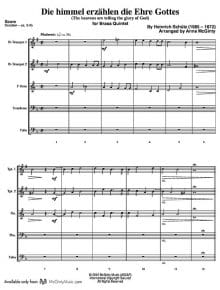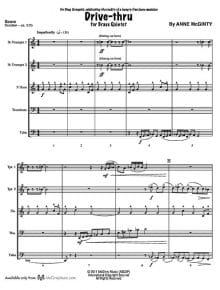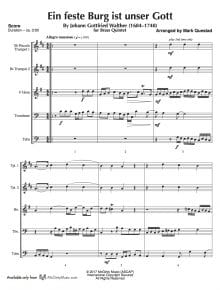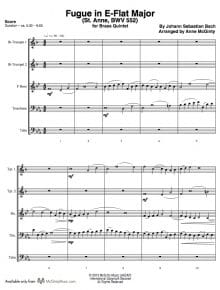Search Music
Music Categories
PDF Download Only
Purchase. Print. Play.
-
Die himmel erzählen die Ehre Gottes (Schütz) – Brass Quintet
Heinrich Schütz (1585 – 1672) was a Renaissance composer and is generally considered the most important German composer prior to Johann Sebastian Bach. His compositions show the influence of his teacher, Gabrieli.
One of the last composers to write in modal style, the text for this piece is from Psalm 19. The title translates to: The heavens are telling the glory of God.
Originally written for six voices, the piece is ideal for brass quintet and will sound glorious in a church or recital setting.
Thanks to the Vista Brass Quintet for sending a recording of this piece.
The Vista Brass Quintet features Emily Lawyer and Tim Winfield – trumpet, Anne Marie Cherry – horn, Charles Lilly – trombone and Todd Eames – bass trombone.
Composer: Anne McGinty
Instrumentation: 2 Trumpets, Horn, Trombone & Tuba
Duration/# of Pages: ca. 3:45 / 23 pages, 8.5″ x 11″
Key: N/A -
Drive-thru – Brass Quintet
Hungry? This is an impatient trip through traffic on the way to the drive-thru. There are blaring horns, near collisions, a dump truck backing up (so obnoxious and so irritating), and finally there you are, waiting in line. The 1st trumpet asks “may I take your order” and finally the tuba gets to order a cheeseburger, fries and a chocolate milkshake. The order is, of course, repeated over the speaker, accomplished by trombone with a harmon. More waiting, more impatience, more car horns, and finally you are satisfied. Aaah
This piece will be a great hit with your audience. And there are absolutely no calories!
The mp3 excerpt is from the Tower Brass Quintet CD, Road Trip. (Used with permission.)
Composer: Anne McGinty
Instrumentation: 2 Trumpets, Horn, Trombone & Tuba
Duration/# of Pages: ca. 3:25 / 21 pages, 8.5″ x 11″
Key: N/A -
Ein feste Burg ist unser Gott – Brass Quintet
This piece by Johann Gottfried Walther sets the horn, trombone and tuba in energetic counterpoint while the trumpets proclaim the chorale melody overtop.
The mp3 excerpt is performed by the Sine Nomine Brass Quintet. (Used with permission.)
Composer: Mark Questad
Instrumentation: 2 Bb Trumpets, F Horn, Trombone & Tuba
Duration/# of Pages: ca. 3:00 / 9 pages, 8.5″ x 11″
Key: C -
Fugue in E-Flat Major (J.S. Bach) – Brass Quintet
“The triple fugue … is a symbol of the Trinity. The same theme recurs in three connected fugues, but each time with another personality. The first fugue is calm and majestic, with an absolutely uniform movement throughout; in the second the theme seems to be disguised, and is only occasionally recognisable in its true shape, as if to suggest the divine assumption of an earthly form; in the third, it is transformed into rushing semiquavers as if the Pentacostal wind were coming roaring from heaven.” ~ Albert Schweitzer
The Fugue in E-Flat Major (BWV 552) has become known in English-speaking countries as the “St. Anne” because of the first theme's resemblance to the St. Anne hymn O God, Our Help in Ages Past, a hymn that would have been unknown to Bach. A fugue in three sections of 36 bars, 45 bars and 36 bars, with each section a separate fugue on a different theme, it has been called a triple fugue, although only the first theme is combined with the second and third themes; for that reason the second and third sections are sometimes referred to as double fugues. The number three is pervasive and has been understood to represent the Trinity. The description of Albert Schweitzer follows the nineteenth century tradition of associating the three sections with the three different parts of the Trinity. The number three, however, occurs many other times: in the number of flats of the key signature; in the number of sections; and in the number of bars in each section, each a multiple of 3 x 3. Each of the three themes of the fugues seems to grow from the previous ones.
Written for organ, the ranges of each of the five fugal voices works well for the five brass instruments. Articulations and minimal dynamic suggestions have been added to honor the music, to make it sound as it would have sounded if the fugue were conceived for these modern instruments. The tuba can play m. 114 to the end down an octave to sound more like an organ pedal.
This fugue is available for brass ensemble as well as brass quintet There are Eb trumpet parts included with the brass quintet version. The brass ensemble version has the traditional brass quintet parts, Eb trumpet parts, Eb horn, Euphonium TC and Eb tuba.
The mp3 excerpt is from the Tower Brass Quintet CD, Road Trip. (Used with permission.)
Composer: Anne McGinty
Instrumentation: 2 Bb and/or Eb Trumpets, F Horn, Trombone & Tuba
Duration/# of Pages: ca. 5:30 / 28 pages, 8.5″ x 11″
Key: Eb




